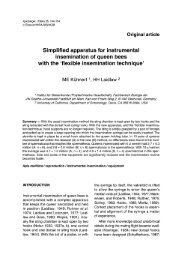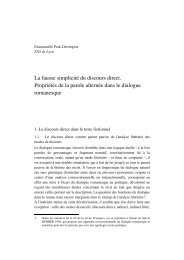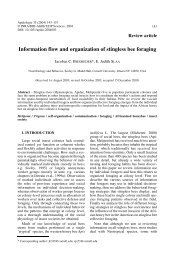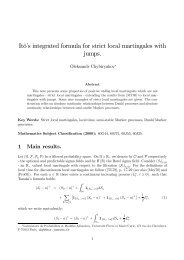ARBEITSGEMEINSCHAFT DER INSTITUTE FÜR ... - HAL - INRIA
ARBEITSGEMEINSCHAFT DER INSTITUTE FÜR ... - HAL - INRIA
ARBEITSGEMEINSCHAFT DER INSTITUTE FÜR ... - HAL - INRIA
You also want an ePaper? Increase the reach of your titles
YUMPU automatically turns print PDFs into web optimized ePapers that Google loves.
-<br />
A<br />
-<br />
It<br />
Bienen in größeren Zellen auch normal mehr Futter erhalten (M ESSAGE und<br />
GON(;Al,VES).<br />
3. In vitro-Reproduktion von Varroa. Für diese Versuche wurden Varroa-<br />
Weibchen aus Bienenbrut gesammelt. Die besten Erfolge hatten wir mit Milben, die<br />
kürzlich verdeckelter Arbieterinnen-Brut entnommen wurden. Die in vitro-<br />
Versuche wurden in künstlichen Zellen aus Wachs im Brutschrank bei 34 °C<br />
und 85 bis 90 % Feuchte angesetzt. Pro Kunstzelle wurden eine Bienenmade des<br />
späten L5 und ein Varroa-Weibchen eingesetzt. Es wurden Arbeiterinnen-, Drohnen-<br />
und Königinnen-Larven als Wirt getestet. Die Nachkommen der Milben<br />
der in vitro-Ansätze konnten zum Teil bis zur Deutonymphe aufgezogen werden.<br />
Alle Typen von Bienenlarven sind als Wirt für die in vitro-Reproduktion der<br />
Varroa-Milbe geeignet. Am besten haben jedoch die Versuche mit Arbeiterinnen<br />
und Drohnen-Larven geklappt (C AVICCHIO IssA und GoN!ALVES).<br />
4. Schwarmverhalten. Mit Hilfe eines sogennanten Apidometers kann über<br />
vorgeschaltete Fotozellen die Flugaktivität von Bienenvölkern permanent kontrolliert<br />
werden. Faktoren wie Volksgröße, Temperatur, Luftfeuchtigkeit, Varroa-<br />
Befall müssen dabei berücksichtigt werden (B URIOLLA und GoN!ALVES).<br />
SUMMARY<br />
The Varroa Research Program in the Honey Bee Laboratory<br />
of the University of Sao Paulo in Ribeirao Preto<br />
The mite Varroa jacobsoni was introduced into Brazil about 15 years ago.<br />
The mite came from Japan through Paraguay. The infestation rate has remained<br />
low until now (2 to 3 %). Since 1979 our laboratory has worked on the<br />
Varroa Project. Some of the results obtained were reported<br />
as follow :<br />
feature of Brazilian apiculture that makes Varroa control difficult<br />
is the many feral colonies. Thirty-two such colonies were checked around<br />
Ribeirao Preto, in the state of Sao Paulo. Only three colonies were free of<br />
mites. It appears that not a single mite-free colony exists now in the state.<br />
This implies a very efficient dispersal mechanism by the mites. It seems the<br />
Africanized bees developed resistance to Varroa (G ONÇALVES , NOGUEIRA and<br />
DL JONG ).<br />
was observed that the size of the worker cells in wax comb have a<br />
great influence on the level of the mite infestation of worker brood. Workers<br />
of Africanized bees that developed in small cells had an infestation rate significantly<br />
lower than the ones developed in large cells. In one set of data the<br />
infestation rate in small cells was half that in large cells. The pupae that<br />
developed in large cells had a significantly greater weight than those developed




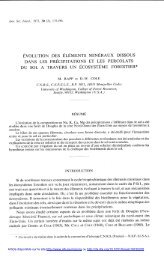
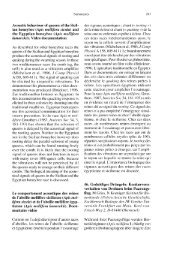
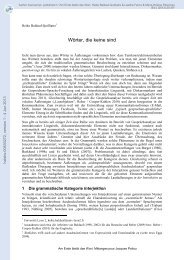
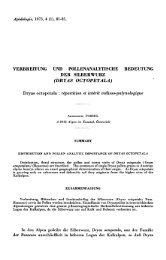
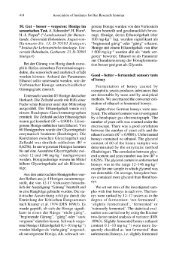
![4 C]-Polyethylenglykol bestimmt, der - HAL - INRIA](https://img.yumpu.com/22454280/1/177x260/4-c-polyethylenglykol-bestimmt-der-hal-inria.jpg?quality=85)
